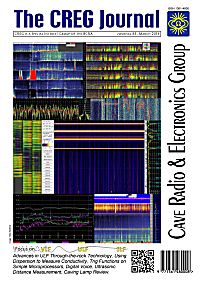
- The most recent issue to be published was 132
- For further information, please see Publishing/Despatch Schedule
- Database last updated on Mon, 01 Dec 2025 18:30:34 +0000
- Online access is currently available for all issues. Some of
the older issues are bit-map scans rather than digital copies.
journal scans.
- Online voting for CREG articles was withdrawn in June 2022. For info see
Voting for CREG articles
Contents of journal 85
March 2014
This page may take a few
seconds to load. Please wait ...
- CREG Journal 85 (0-24)
(PDF 6.4MB)
  Individual articles may be available below Individual articles may be available below
- This issue has a cover date of March 2014 and was published on 1 March 2014. The online version is now at version 2, and contains some minor corrections to pages 2 and 8.
-
- Front Cover (1)
(PDF 2.3MB)

- Many experimental lower frequency modes employ very low data rates, with long distance reception often at very low signal strengths. Reception often relies on software to produce spectrographic displays; displaying both wanted and unwanted signals and using colour to aid discrimination. Image: Mike Bedford
-
- Contents (2)
(PDF 241KB)

- List of Contents and masthead information
-
- VLF and Down: the Bottom End of the Radio Spectrum (3-4)
(PDF 97KB)

- In this issue we have several articles concerning radio operating in the VLF portion of the spectrum and below. Here Mike Bedford introduces this topic and provides some background material.
-
- Amateur Experiments at VLF (4)
(PDF 45KB)

- Further to Mike Dennison's guide to experimenting in this part of the spectrum (Dennison, 2014), John Rabson provides some information on recent tests and results.
-
- Experimenting with VLF - Some Practical Guidance (5-6)
(PDF 449KB)

- Radio amateurs in several countries are now permitted to work at VLF with potential spin-offs for cave radio. Mike Dennison provides some guidance for those wanting to experiment in this part of the radio spectrum.
-
- Using Dispersion to Measure Ground Conductivity (7-8, 19)
(PDF 518KB)

- Several methods of remotely measuring ground conductivity are known, which depend on measuring the amplitude and phase of a received signal, relative to its transmitter. All of these methods require the separate transmission of a phase reference signal, with attendant difficulties. David Gibson proposes that by transmitting a suitably constructed signal, a phase measurement may be made without the need for a separate reference. This is achieved by making use of the phenomenon of dispersion, in which the phase velocity of a wave depends on its frequency. A related technique that makes relative measurements of signal amplitude is also described.
-
- Advances in ULF Through-the-rock Technology (9-12)
(PDF 1.7MB)

- Mike Roper, CTO at Vital Alert Communication Inc. describes the unique challenges posed by mine communication and introduces the Canary ULF radio that was designed to meet these challenges.
-
- State-of-the-Art Overview of Caving Lamps - Part 2 (13-15)
(PDF 837KB)

- Mike Bedford concludes his round-up of today's caving and mining lamps and summarises his findings with a tabular comparison of the lamps included in both parts of this article.
-
- We Hear (16)
(PDF 642KB)

- News and events - Mike Bedford brings us the latest to impact the world of cave radio and electronics, including African Show Cave Comms, LORAN Returns in USA?, Fabric Batteries, Spider Fuel Cell, Biomimetic Undersea Robot.
-
- Calculating Trigonometric Functions on a Simple Microprocessor (17-18)
(PDF 322KB)

- As an alternative to look-up tables, Ian Todd describes the CORDIC method of accurately calculating trigonometric functions on simple microprocessors.
-
- Letter and Notes (19)
(PDF 289KB)

- Bat Detector Loudspeaker, Radiolocation Kits.
-
- Web Watch (19) For download see previous item
- A brief selection of links from Peter Ludwig.
-
- Digital Voice in Cave Radio (20)
(PDF 216KB)

- There is increasing interest amongst radio amateurs in using digital voice systems over radio. John Rabson provides some information on current techniques that may be useful below ground.
-
- Ultrasonic Distance Measurement Investigations (21-24)
(PDF 1.4MB)

- Chris Hunter describes the development of cost-effective distance measuring equipment in which the ultrasonic transmitter and receiver are separated and linked by radio.
-
- The Adventures of GREG (24)
(PDF 733KB)

- Illustrations by Adrian Higgins with words by Mike Bedford.
-

|

View Contents:

BCRA is a UK registered charity and is a constituent body of
the British Caving Association,
undertaking charitable activities on behalf of the BCA.
BCRA publishes a range of periodicals and books.
Click here for further information.
|
Searching
To Search our pages using Google, type a search
string in the box at the top of the page and hit your Return key
You can also search our publications catalogue at the British Caving Library
The CREG Journal Search Engine is a new, powerful search engine which will, sometime, be extended
to cover Cave & Karst Science. We have a keyword search facility on our Cave Science Indexes pages but this may be rather out-of-date.
|
For staff use: Link to Database
Show/Hide
download figures next to each item (if available and non-zero; you might need to refresh page first). Counters last
reset on Thu 03-Jan-2019 17:29:28 +00:00. The figures are non-unique
click-throughs.
|









